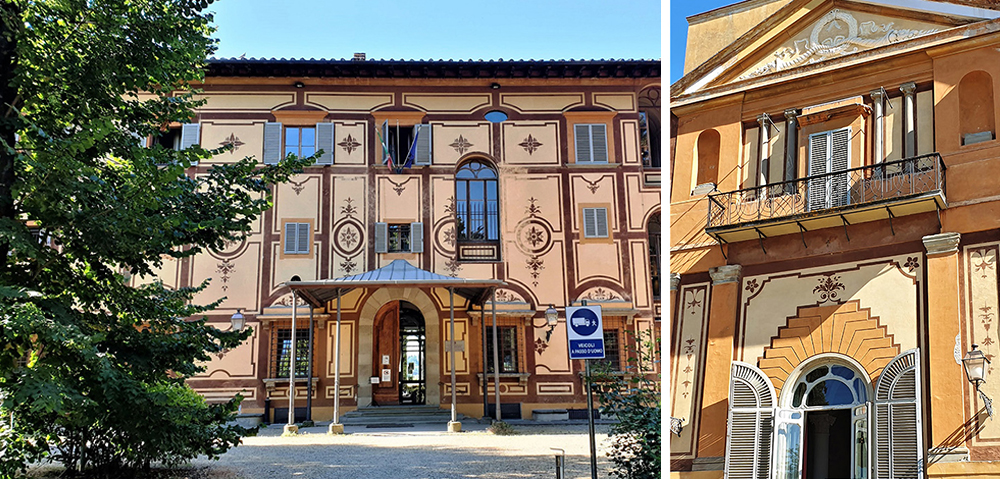
The gardens of Florence - Villa Favard in Rovezzano
Eastern suburbs of Florence, in Rovezzano, a public park with a large villa in the center, Villa Favard (not to be confused with the homonymous villa in via Curtatone, home of the Polimoda Fashion School).
The history of this place begins at the end of 1200, in a Florence torn apart by the internal war between White and Black Guelphs, two political factions which include the main city families. The White Guelphs, led by the Cerchi, think that the Pope should have only spiritual power and, in particular, that he should not interfere in the political life of Florence. The Black Guelphs, to which belong the great Florentine families of bankers and led by the Donati, manage the papal finances and therefore have every interest in letting the Pope influence Florentine internal politics.
Of course, the richest wins. The Pope succeeds in obtaining the help of the king of France against the White Guelphs of Florence and the story ends in 1301 with 170 death sentences and the exile and confiscation of all properties for 600 White Guelph citizens, including Dante Alighieri.
Villa Favard di Rovezzano, then known as "Palagio dei Pini", which was build in 1200 as a fortified farm of the Cerchi family, passed to the families of the Black Guelphs, first the Riccardi and then the Bartolini Salimbeni. After 1530, the latter commissioned the renovation of the villa to Baccio d'Agnolo, an important architect of the Florentine Renaissance who had also worked on Palazzo Vecchio and the Dome of the Cathedral of Santa Maria del Fiore.
The medieval farm-fortress is transformed into a typical Renaissance aristocratic villa with arcades, loggias, large kitchens and warehouses for wine, oil and food. A large park is created around it with lawns, tree-lined avenues, box hedges, pergolas, orchards and water basins.
The facade was then
further remodeled, in the Mannerist era, by Giulio Parigi, another important
Florentine architect, a pupil of Bernardo
Buontalenti.

In the nineteenth century, through other changes of ownership, the villa was finally bought by Baroness Fiorella Suzanne Favard de l'Anglade. She was born in Livorno in 1813, she had lived mainly in France where she had accumulated great wealth. Probably the noble title was invented, but the alleged baroness was still a fascinating woman, very intelligent and cultured, a lover of art and culture, who gathered around her in Florence all the artists and intellectuals of the time.
As soon as she came into
possession of the villa, she proceeded with the restructuring already decided
by the previous owner, which had been entrusted to Giuseppe Poggi, the most important Florentine architect of the 19th
century.

With Poggi, the villa and the park get their present appearance. Many Renaissance elements are eliminated, the exterior is rationalized and geometrized, and important changes are made in the park and in the interiors. The large internal courtyard, which dates back to the medieval fortress, is covered by a glass and iron skylight and the space transformed into a large ballroom with a stage for the orchestra.
These are the times when Florence was the capital of Italy and the seat of the king and his court. It's time for big parties and receptions and Baroness Favard is at the center of social life, so she needs large spaces.
A canopy supported by six cast iron columns leading to the main door is added so that guests can get off the carriages without getting wet when it rains.
The facades are very characteristic and have a brick red geometric decoration on all four sides that encloses the windows, doors and stylized floral decorations.
Outside Giuseppe Poggi
built various structures scattered throughout the area, such as the large glass
greenhouses, the coffeehouse
for outdoor breakfasts and snacks in the fashion of the time, the lemon house,
the grain and dried fruit warehouses and even the baroness's dog cemetery. Poggi had also placed many sculptures in
the park, including two beautiful marble lions, but over the years they were
stolen and never recovered.
Lastly, the funerary chapel where Baroness Favard was buried, which contains important frescoes by Annibale Gatti and sculptures by Giovanni Duprè.
From the death of the baroness to the acquisition of the villa by the Municipality of Florence in 1982, the structure has had various uses. Some very particular: during the war it was a warehouse for German tanks, then a command and warehouse for the Anglo-American allies, then the headquarters of the Florentine Artisan Tessitura which produced luxury fabrics, then a refuge for children in economic and social difficulties, and over the years '70 and the park became a sort of campsite for young tourists who at that time used to sleep outdoors in public gardens.
In the 1980s, the park was renovated by the municipality which made it a public area suitable for families as well.
Villa Favard is one of
the little known jewels of Florence. Today it is a detached seat of the Luigi Cherubini Conservatory of Music
and if you sit on a bench in the shade of a monumental cedar of Lebanon, you
can hear the piano exercises of the conservatory students or the vocalizations
of future opera singers!




